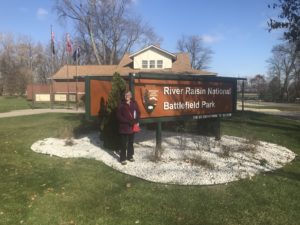 Adventure days with my parents are lots of fun and we decided to visit a couple of National Park sites in November before it got too cold. Ha! Of course we picked the coldest day in November! But it was clear and sunny and we had a very interesting visit to River Raisin National Battlefield in Monroe, Michigan.
Adventure days with my parents are lots of fun and we decided to visit a couple of National Park sites in November before it got too cold. Ha! Of course we picked the coldest day in November! But it was clear and sunny and we had a very interesting visit to River Raisin National Battlefield in Monroe, Michigan.
River Raisin National Battlefield became a National Park site in 2009, but it had been a Michigan State Historic site since 1952. It is also listed on the National Register of Historic Places. This is the only National Battlefield marking a battle from the War of 1812. The battle was a victory for Tecumseh‘s American Indian Confederation and a defeat for the United States.
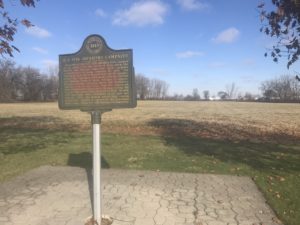 I don’t really know a lot about the War of 1812, even though it was centered in New York and Ohio. In the River Raisin battle, the British and Native Americans attacked the settlement of Frenchtown on January 18 and were driven back by the townspeople and a militia from Kentucky. But, on January 22, the British coalition attacked again, killing 397 Americans and taking 547 prisoner. It was the costliest battle of the War of 1812 for the United States.
I don’t really know a lot about the War of 1812, even though it was centered in New York and Ohio. In the River Raisin battle, the British and Native Americans attacked the settlement of Frenchtown on January 18 and were driven back by the townspeople and a militia from Kentucky. But, on January 22, the British coalition attacked again, killing 397 Americans and taking 547 prisoner. It was the costliest battle of the War of 1812 for the United States.
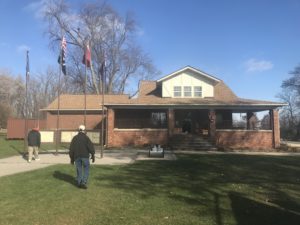 The Visitors Center for River Raisin National Battlefield is along the bank of the River Raisin. The River Raisin flows into Lake Erie which is very close. We picked up my parents, drove through Toledo, and got to the Visitors Center in a couple of hours. The Visitors Center is small and crowded with displays tucked everywhere. The Battlefield just got a grant for a new Visitors Center and Museum and Living History area beside the river. It will be wonderful when it is completed in a couple of years.
The Visitors Center for River Raisin National Battlefield is along the bank of the River Raisin. The River Raisin flows into Lake Erie which is very close. We picked up my parents, drove through Toledo, and got to the Visitors Center in a couple of hours. The Visitors Center is small and crowded with displays tucked everywhere. The Battlefield just got a grant for a new Visitors Center and Museum and Living History area beside the river. It will be wonderful when it is completed in a couple of years.
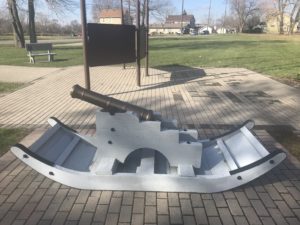
We watched the movie which did a nice job of laying out the battle, then looked at the displays in the museum. We also spent quite a while talking to the ranger. When a school group came in for a field trip the noise level went way up, so we headed out to the battlefield.
The Battlefield is small, located around the fenced perimeter of Frenchtown at the time. There were a couple of monuments and some waysides along a short trail. Because it was so cold, we didn’t linger as we read the signs. There is also a longer trail but it isn’t developed as an interpretive site yet.
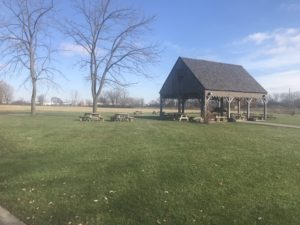 We are fascinated to discover a previously unknown bit of our American history. As we have shared our visit with others, they repeatedly say, “I never heard of that!” Amazing what we don’t know about American history, especially so close to home!
We are fascinated to discover a previously unknown bit of our American history. As we have shared our visit with others, they repeatedly say, “I never heard of that!” Amazing what we don’t know about American history, especially so close to home!
